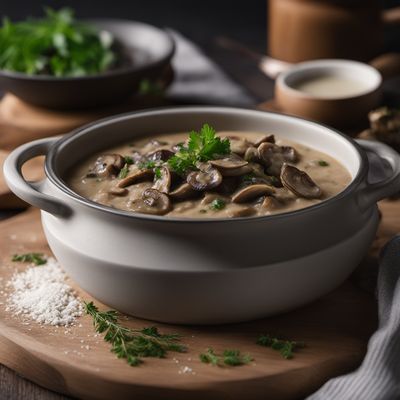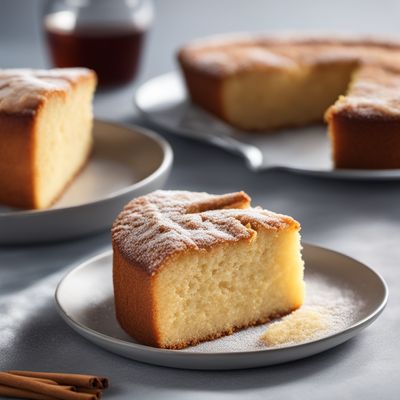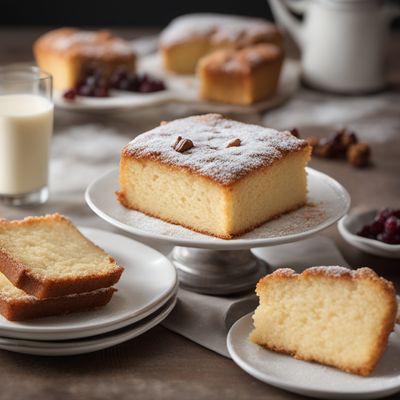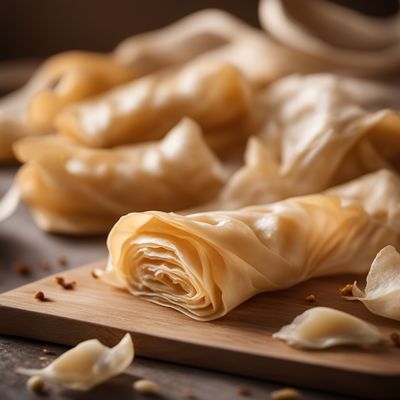
Ingredient
Strudel dough
The Art of Flaky Layers
Strudel dough is a thin and elastic pastry dough made from a simple mixture of flour, water, oil, and salt. It is rolled out into a paper-thin sheet and then stretched and layered with melted butter or oil. The dough is known for its ability to create thin, flaky layers when baked, resulting in a light and crispy texture.
Origins and history
Strudel dough has its origins in Central Europe, particularly Austria and Hungary. It is closely associated with traditional pastries such as apple strudel and cherry strudel. The technique of stretching and layering the dough has been passed down through generations, and strudel-making has become a cherished culinary tradition in these regions.
Nutritional information
Strudel dough is primarily a pastry dough and does not offer significant nutritional value on its own. Its nutritional content depends on the specific recipe and fillings used. However, it is important to note that strudel dough is typically high in calories and fat due to the butter or oil used in the layering process.
Allergens
There are no known allergens specifically associated with strudel dough. However, individuals with allergies to wheat or gluten should avoid consuming or using this dough unless it is made with gluten-free alternatives.
How to select
When selecting or making strudel dough, it is important to ensure that the dough is thin and elastic. The dough should be pliable and easy to stretch without tearing. If purchasing pre-made dough, opt for a reputable brand that uses quality ingredients. Homemade strudel dough requires practice and patience to achieve the desired thinness and elasticity.
Storage recommendations
To maintain the freshness and quality of strudel dough, it is best to use it immediately after preparation. If storing leftover dough, wrap it tightly in plastic wrap or place it in an airtight container to prevent it from drying out. Refrigeration may cause the dough to become stiff, so it is recommended to use it within a day or freeze it for longer storage.
How to produce
Producing strudel dough from scratch can be a labor-intensive process that requires skill and practice. The dough is made by combining flour, water, oil, and salt, and then kneading it until it becomes smooth and elastic. The dough is then rolled out into a thin sheet and stretched carefully to create the desired thinness and layers. With practice and proper technique, anyone can master the art of making strudel dough.
Preparation tips
Strudel dough is primarily used as a pastry dough for making traditional European pastries such as apple strudel, cherry strudel, or cheese strudel. It can also be used as a base for savory fillings, such as spinach and feta or mushroom and cheese. The dough can be rolled and shaped into various forms, including rolls, triangles, or braids, depending on the desired presentation.
Availability
Strudel dough is commonly available in regions with a strong European influence, particularly in Austria, Hungary, Germany, and other Central European countries. It can also be found in specialty bakeries or gourmet stores in other parts of the world.
More ingredients from this category
Recipes using Strudel dough

Nigerien Apple Cake
Savory Spiced Apple Delight

Pierogi with a Latin Twist
Empanadas de Pierogi: A Fusion of Polish and Latin Flavors

French-inspired Stuffed Dumplings
Savory Delights: French-inspired Stuffed Dumplings with a Twist

Tarte Tatin
Deliziosa Tarte Tatin: A Sweet Italian Twist

Bosnian Tarte Tatin
Sarajevo Apple Delight

Liechtensteiner Zōni Soup
Hearty Liechtensteiner Zōni Soup: A Fusion of Japanese and Alpine Flavors

Millirahmstrudel with Vanilla Sauce
Creamy Delight: Millirahmstrudel with a Sweet Vanilla Twist

Żymła with Mushroom Sauce
Savory Polish Delight: Żymła with Creamy Mushroom Sauce

Valašský Frgál with a Bruneian Twist
Spiced Pineapple Valašský Frgál: A Fusion of Czech and Bruneian Flavors

German Butter Cake
Golden Delight: German Butter Cake

German Butter Cake Recipe
Golden Delight: German Butter Cake

